
Boggle is a word game in which players try to find as many words as they can from a grid of lettered dice, within a set time limit. It was invented by Allan Turoff and originally distributed by Parker Brothers. The game is played using a plastic grid of lettered dice, in which players look for words in sequences of adjacent letters.
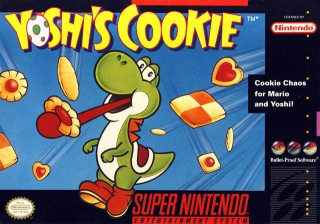
Yoshi's Cookie is a 1992 tile-matching puzzle video game developed by Tose and published by Nintendo for the NES and Game Boy platforms in 1992. A Super NES version was released the following year, developed and published by Bullet-Proof Software.

Mario Party 4 is a 2002 party video game developed by Hudson Soft and published by Nintendo for the GameCube. The game is the fourth installment in the Mario Party series and is the first game in the series to be released for the GameCube. Like the previous games in the series, it features eight playable characters: Mario, Luigi, Princess Peach, Yoshi, Wario, Donkey Kong, Princess Daisy, and Waluigi from the Mario franchise, who can be directed as characters on 6 themed game boards. The objective is to earn as many stars as possible, which are obtained by purchase from a single predefined space on the game board. Each character's movement is determined by a roll of a die, with a roll from each player forming a single turn. Each turn is followed by a minigame in which characters compete for coins they can use to purchase items and stars.

Tetris Worlds is a version of the video game Tetris. Originally released in 2001 for Microsoft Windows and Game Boy Advance, it was later released for Xbox, GameCube, and PlayStation 2 in 2002. In 2003, an Xbox Live version and a single-disc compilation version were released for the Xbox. The latter was bundled with Xbox systems.

Mario Party 5 is a party video game developed by Hudson Soft and published by Nintendo for the GameCube. It is the fifth installment in the Mario Party series and the second game in the series to be released for the GameCube. It was first released in North America and Japan in November 2003, followed by Europe a month later. The game is set in the fictional Dream Depot, consisting of seven game boards. The single-player "Story" mode involves the player winning multiple games against the Koopa Kids to prevent Bowser from conquering the Dream Depot. The main multiplayer game mode consists of four characters from the Mario series playing a board game, with each board having a set theme. The game also features several minigames, which are played after every set of turns. Mario Party 5 introduces the "Super Duel" mode to the franchise, which requires players to assemble and control custom made battle vehicles which can be used in combat against other machines. The game features ten playable characters, with playable debuts to the series from Toad, Boo, and Koopa Kid.

Mario Party is a party video game series featuring characters from the Mario franchise in which up to four local players or computer-controlled characters compete in a board game interspersed with minigames. The games are currently developed by NDcube and published by Nintendo, being previously developed by Hudson Soft. The series is known for its party game elements, including the often unpredictable multiplayer modes that allow play with up to four, and sometimes eight, human players or CPUs.

I.Q.: Intelligent Qube, also known as Intelligent Qube in North America and Kurushi in Europe, is a puzzle video game for the PlayStation. In the game, the player controls a character who must run around a platform made of cubes, clearing certain cubes as they approach. Cubes are "cleared" by marking a spot on the stage, waiting for the cube to roll on top of it, and then deactivating the marked spot.

TimeSplitters 2 is a first-person shooter video game developed by Free Radical Design and published by Eidos Interactive for PlayStation 2, Xbox and GameCube game consoles. It is the second game in the TimeSplitters series, and a sequel to the original TimeSplitters.

Brain Age: Train Your Brain in Minutes a Day!, known as Dr. Kawashima's Brain Training: How Old Is Your Brain? in PAL regions, is an edutainment puzzle video game. It was developed and published by Nintendo for the Nintendo DS. Nintendo has stated that it is an entertainment product inspired by Tohoku University professor Ryuta Kawashima's work in the neurosciences.

Bomberman Generation is a 2002 video game released for the GameCube. It was followed up by Bomberman Jetters.

Bomberman Jetters is an action game for the Game Boy Advance, GameCube and PlayStation 2, and part of Hudson Soft's Bomberman series. The game builds on the gameplay style established in the previous Bomberman series entry, 2002's Bomberman Generation, and features characters and settings from the 2002 anime series Bomberman Jetters. The GameCube version utilizes cel-shaded graphics similar to those of Bomberman Generation, while the PlayStation 2 version does not.
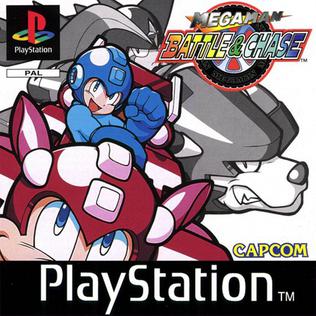
Mega Man: Battle & Chase is a racing video game based on the original Mega Man series from Capcom. The game was released in Japan on March 20, 1997 and in the PAL region on April 3, 1998 for PlayStation. Although it was not released individually in North America, Mega Man: Battle & Chase was featured on the region-exclusive Mega Man X Collection in 2006. Mega Man: Battle & Chase is a traditional racing game with an emphasis on combat. Winning a race allows the player to choose a car part from an enemy competitor as a prize. Reviews for the game have been mixed with many critics drawing comparisons to Nintendo's Mario Kart series.

Bookworm is a word-forming puzzle video game by PopCap Games. From a grid of available letters, players connect letters to form words. As words are formed, they are removed from the grid and the remaining letters collapse to fill the available space. Players earn more points by creating longer words or words which use less common letters and earn less for smaller words. In November 2006, PopCap Games released a sequel, Bookworm Adventures. Bookworm was released for the Nintendo DS digital distribution service DSiWare on November 30, 2009. It has also been released on the regular Nintendo DS cartridge.

PK: Out of the Shadows is a 2002 action-adventure video game developed by Ubi Soft Montreal and published by Ubi Soft. It stars Donald Duck as Paperinik or "PK" as he battles to stop the Evron Empire from taking over Earth. The game is based on the Italian comic book series PK – Paperinik New Adventures.

Picross DS (ピクロスDS) is a puzzle video game developed by Jupiter and published by Nintendo for the Nintendo DS handheld video game console. It is the second Picross game to be released by Nintendo in Europe and North America after Mario's Picross suffered a commercial failure in regions outside Japan, where many Picross games have been released for several Nintendo consoles. Like other Picross games, it presents the player with a series of nonogram logic puzzles to solve. It was first released in Japan, and was later released in North America, Europe and Australia.

Bananagrams is a word game invented by Abraham Nathanson and Rena Nathanson of Cranston, Rhode Island, wherein lettered tiles are used to spell words.

Battle Poker is a WiiWare game by Left Field Productions that was released in North America on July 20, 2009. It's also available on PlayStation Portable on December 10, 2009.
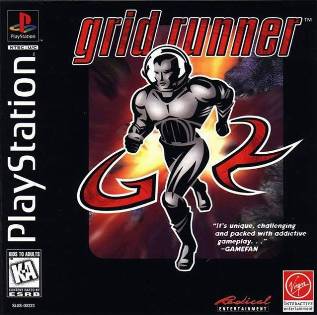
Grid Runner is an action game developed by Radical Entertainment and published by Virgin Interactive Entertainment for the Sega Saturn, PlayStation, and Microsoft Windows in 1996. It is frequently described as a cross between tag and capture the flag, but the playing field is a maze-like grid which the players can manipulate to an extent. Players can either compete against each other in one-on-one matches or take on a series of AI opponents in the game's story mode. Grid Runner was first announced under the title "Eurit".
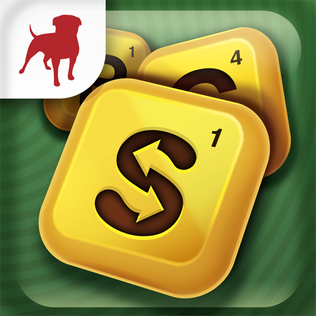
Word Streak is a word game developed by Zynga with Friends for iOS and Android and released in January 2012. Gameplay is similar to that of Boggle—players try to find as many words as possible in a jumbled 4x4 grid of letters by connecting adjacent letters to form words within a two-minute time frame - though with extra features and a different scoring system. Words may be formed vertically, horizontally, and diagonally. Scramble with Friends is one of the top ranking games in the iOS application store, available as both a free ad-supported version and an ad-less paid version. Scramble with Friends replaced Scramble Challenge at the end of 2011, but did not retain the solitaire option of the latter.
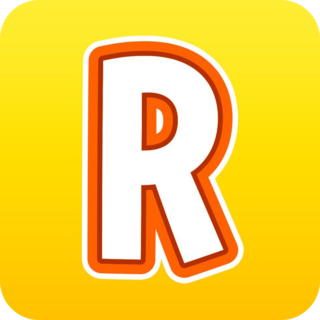
Ruzzle is a mobile game developed by Swedish gaming company MAG Interactive and was first published in the Apple Store in March 2012. Ruzzle is inspired by the classic board games Boggle and Scrabble. The game is highly social and based on online matches, requiring the player to find an opponent who can be appointed randomly by the system from online users, chosen from a list of friends set by the player, or selected from amongst their Facebook friends. Ruzzle is now available for iOS, Android, and Windows Phones.


















